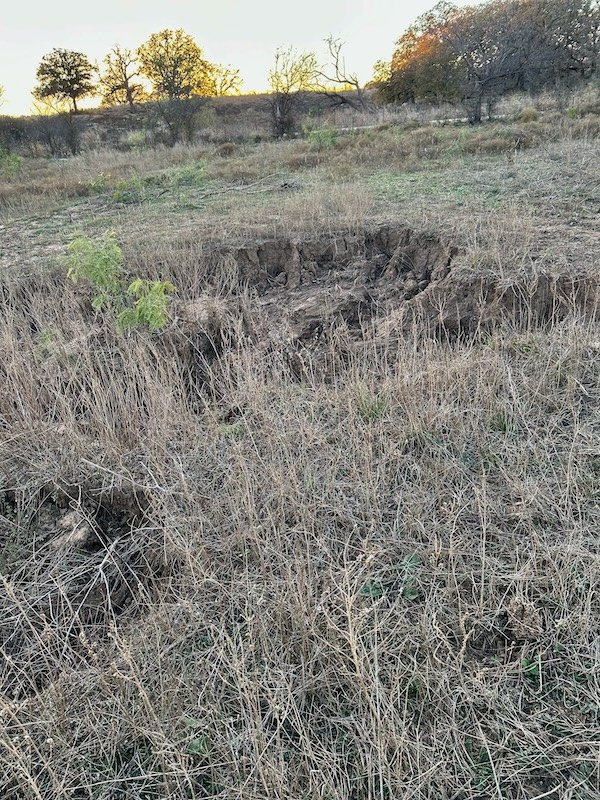
When we were growing up in the 1950’s, 60’s and 70’s, we spent many happy days on the ranch visiting our grandparents. Having acquired the main portion of the ranch in 1928, our grandparents were excellent stewards of the land. Our grandfather raised cattle, sheep and dryland peanuts. He had a large garden near the farmhouse.
As we remember it, the grass always looked plentiful. There was little or no bare ground anywhere. The soil was teeming with subterranean life. If we needed bait for fishing, we could take a shovel with us to the nearest stock pond and dig up a shovelful of earthworms. Dung beetles were a source of entertainment, along with butterflies and wild honey bees. Our grandfather, along with his sheep and cattle, kept the brush and mesquite trees under control. We could easily walk anywhere on the place without being impeded in any overgrowth. Our favorite pastime was exploring up and down the creek that runs diagonally across the ranch. It was on average about 10 feet deep and 20 feet wide. The ranch was replete with wildlife including squirrels, horned lizards (horny toads), bobcats, raptors, quail, dove, waterfowl, foxes, o’possums, skunks, rabbits, deer and armadillos.
After our grandparents passed away in the early 70’s, our family members managed the ranch. We implemented many improvements including new fences, new coastal bermuda fields, mesquite eradication, a new shop building, stock pond cleanouts and a large new stock pond.
As family members grew older, the ranch improvements waned but we continued to practice continuous grazing with livestock wandering at will throughout the pastures. As a result, the ranch is in poor shape at present. Current status is summarized as follows:
- Pastures are in poor condition with spotty grass, broom weed infestations, uncontrolled brush, mesquite coverage and significant patches of bare dirt.
- The creek is now 5 feet deeper and 15 feet wider than it was under our grandfather’s watch.
- There is active erosion underway into the creek with large new ravines forming in the pastures.
- Approximately half of the perimeter fencing had to be replaced. Fence replacement is now 90% complete.
- Invasive coyotes and feral hogs have their run of the place
- Horny toads and quail have completely disappeared. We assume this was caused by the following factors:
- Fire ant incursions
- Pesticides broadcast to fight fire ants killed killed both the horny toads and the harvester ants that make up their diet. The harvester ants have now recovered but the horny toads have not.
- Widespread adoption of coastal bermuda grass for hay fields throughout our region eliminated the native grasses. Coastal bermuda does not produce seeds which the harvester ants eat. Coastal bermuda hay fields are no-go zones for horny toads and other wildlife like quail that are dependent on grass seeds in their diet.
- Feral hogs and coyotes may be eating horny toads and/or disturbing their nests
- There are no earthworms in the topsoil. We assume this was caused by improper use of cattle dewormers, antibiotics and chemical fertilizers.
- There is little to no organic matter or insects in and on the soil. Notably, there are no dung beetles at work. We assume that over-grazing, dewormers, antibiotics, herbicides, insecticides and chemical fertilizers are the culprits.
- Some of the stock ponds have silted up and need to be cleaned out. The stock pond dams have become overgrown with brush and trees, leading to stock pond water leakage.
- A heavy fuel load of brush has built up around our large oak and pecan trees. This places these beautiful hundred year+ trees at significant risk in the event a grass fire comes through the ranch.
- We’ve lost a significant amount of topsoil to erosion. There is significantly more orange sandstone protruding on the pastures surfaces now than when our grandparents operated the ranch. At the current rate of erosion, there won’t be much topsoil left in 50 years.
To further document baseline conditions as we begin our ranch regeneration efforts, we’ll be doing the following:
- Soil fertility and permeability testing
- Soil microbiome testing
- Grass inventory and grass coverage
- Photo and video records of pasture and creek conditions including drone video footage
- Etc.
We’ll update this post as our baseline documentation efforts are completed. These baseline records will help us measure progress and alter course as necessary during our regeneration projects.
Leave a Reply